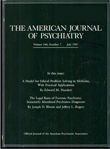Central serotonin activity and aggression: inverse relationship with prolactin response to d-fenfluramine, but not CSF 5-HIAA concentration, in human subjects
Abstract
OBJECTIVE: This study compared the nature and magnitude of the relationship between aggression and CSF 5-hydroxyindoleacetic acid (5- HIAA) concentration with that between aggression and the prolactin response to d-fenfluramine challenge in human subjects. METHOD: The Life History of Aggression assessment scores of 24 subjects with personality disorders were compared with their lumbar CSF 5-HIAA concentrations and with their prolactin responses to d-fenfluramine challenge. RESULTS: Aggression was significantly and inversely correlated with prolactin responses to d-fenfluramine challenge but not with lumbar CSF 5-HIAA concentrations in these subjects. CONCLUSIONS: Prolactin response to d-fenfluramine may be more sensitive than lumbar CSF 5-HIAA concentration in detecting a relationship between aggression and central serotonin activity in noncriminally violent human subjects.



